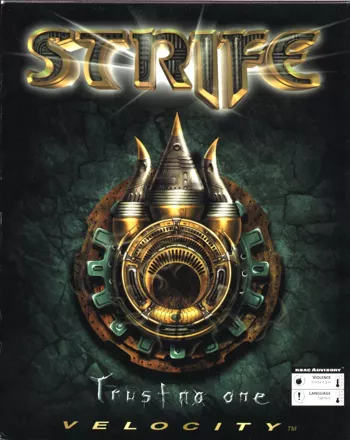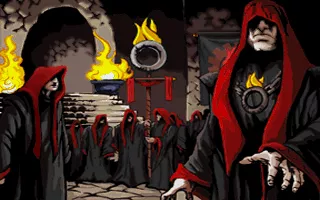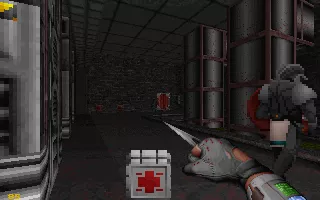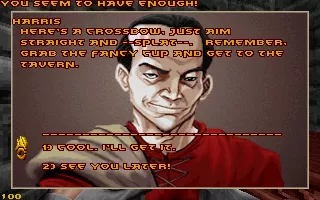Strife
Description official descriptions
In the distant future, the Earth is ruled by a group of people who call themselves "The Order". Many disasters have plagued the planet, and after many wars, misery, and death, the Order controls people's lives and deprives them of their freedom. A rebel organization has been formed, seeking to overthrow the Order and whoever else might be behind their rise to power. Somewhere in the depths of a ruined Town Hall, a group of people who oppose the Order's regime welcome a lone wanderer to become the one who will free the Earth from terror.
Strife is a plot-driven first-person shooter that uses the Doom engine. Rather than taking the player through a linear series of levels, the game offers a continuous world with free-roaming elements and a central "hub" (the town), which the player can visit between missions and explore. Although there are no true role-playing elements in the game, it has several features rarely seen in contemporary FPSs: there are "friendly" areas where there are no enemies but people to talk to, stores where new equipment can be bought, and taverns where the latest gossip is told. The player can also purchase upgrades that permanently increase the player character's health bar.
The game has a branching storyline with a few paths that lead to three different endings. These paths are determined by a decision the player makes during the course of the plot.
Groups +
Screenshots
Promos
Videos
Add Trailer or Gameplay Video +1 point
See any errors or missing info for this game?
You can submit a correction, contribute trivia, add to a game group, add a related site or alternate title.
Credits (DOS version)
78 People · View all
| Executive Producer | |
| Producers | |
| Designer | |
| Level Designers | |
| Writers | |
| Programmers | |
| 3D Engine Licensed from |
|
| Lead Artists | |
| Spin Doctor | |
| Artists | |
| Sound Effects | |
| Music | |
| [ full credits ] | |
Reviews
Critics
Average score: 68% (based on 21 ratings)
Players
Average score: 3.8 out of 5 (based on 60 ratings with 7 reviews)
The Good
This game has a fantastic storyline. Robots, automatic rifles and mutated religious fanatics packed into the medieval times in one. But of course that would be a bit far fetched now wouldn't it? Well before you start the game a narrative depicted in pictures explains how all this became. In short, comet strikes earth, comet releases plague, some survivors mutated into beings known as "The Order" who worship something known as "The Sigil" and those who did not believe in this new religion where brutally beaten, tortured and then "Converted". That's when the rebels and angry peasants come in.....
A special mention also goes to the games graphics, some might see the textures as very blocky and muddy but this is the "Doom" engine pushed to limit. Surprisingly it does a good job of creating an atmosphere, whether it be the grey's and brown's of a medieval town or the dark and light green's of an "Order" temple. The comic-book like art of an important character face as you talk to them is a nice touch and immerses you into this strange world even more.
The levels themselves are great to. They are designed well and look like you would imagine a alien spaceship and underground sewers . My particular favorite is the mission in when "The Front" a resistance group lead by Macil storm "The Order" castle and an large skirmish breaks out between the rebels against robots and cyborgs. The levels are separated using a HUB system meaning instead of linear levels, you can go back and forth from one level to the other which adds to the feeling that this is a real world.
The gameplay is great also and this is what makes Strife a different game from the rest of the doom clones. Instead of shooting everything that moves you have to sometimes actually talk them (amazing I know) to extract information about people, places and objects. Also this is the first game I can remember playing were you have allied soldiers fighting along side you. There is also an RPG element to the game were you have items med packs etc.. to use at anytime. Further more there is also a stat system which determines accuracy and health but apart health the stat system doesn't really affect the game.
Finally the music, even though it's MIDI it can still set the atmosphere for most levels from a rebel underground base to a creepy network of catacombs.
The Bad
There is not much I didn't like about the game apart from maybe one or two levels which are boring endless mazes where you have to solve a puzzle to get out of like "The Sewers" yawn
The A.I is well, laughable but because of the games sometimes restrictive controls, this gives the A.I an advantage because you can't mouse look in the game, also when I played "Doom" non stop when it was first released, I never ever perfected the art of strafing and the same goes for here, even though you can strafe, I find it terribly difficult to turn left,right and strafe at the same time (this is personally speaking of course.)
The save file system is an extremely bad idea as well. I must of had start the game again at least three times because I took at wrong turn got surrounded and had no chance of escaping. This problem can be fixed with a patch though.
The Bottom Line
This game is a CLASSIC. It was one of the first games to combine 1st person shooter and RPG elements into one gaming experience. Think of it as Half-Life's older brother.
DOS · by connor steven (4) · 2005
A truely innovative game which never caught on due to a somewhat outdated engine
The Good
Because it had an actual plot, this was the second FPS (the first being Dark Forces) that I ever had the patience to play from beginning to end. The programmers really did some amazing things with the ol' Doom engine.
For one thing, instead of linear levels the game used a hub system like Hexen where you could go back and forth between several different interconnected areas. Also instead of mission briefings your objectives were relayed to you in-game either by people you talked to or by your everpresent partner "Blackbird" on the radio. This gave the game a smooth transition and seamlessness I hadn't seen since until Half-Life came along.
Also, instead of a dead world populated only by monsters trying to kill you, Strife had various "friendly" areas such as two towns and two rebel bases where you could just wander around and talk to people or buy stuff. Even some of the "action" levels started out friendly and you could even have conversations with the guards (until you started shooting or entered a restricted area, at which point they'd start trying to kill you). Also, there was a great deal of variety to the levels (ranging from occupied town squares to old ruins) instead of the usual endless similar corridors.
When you talked to a major character, you got a close-up screen with comic art and speech. The comic art of the various characters was extremely well drawn, and the speech was pretty good as well. Your partner, Blackbird, also had various funny or oddball things to say over the radio about the various situations you found yourself in.
The action itself was pretty much standard Doom fare, with enemies who weren't too bright but who came at you in ridicuously large numbers. The enemies themselves ranged from the standard gun-toting guards to a variety of cool-looking battle robots. In terms of weaponry there were a few innovations, such as incindery grenades and a flamethrower you could use to sadistically burn your enemies alive, and a crossbow with poison arrows you could use to kill guards without setting off the alarm. There was even an item you could use to teleport friendly rebel soldiers to your location to fight for you (albeit not particularly well).
Also helping to set this game apart were the various set pieces in it. For example, at several points in the game you could sneak past hordes of guards with a fake ID or by pretending to be the janitor. One particularly fun level had you storming an enemy castle, and fighting alongside you was a small army of rebels engaging the enemie's forces in a large scale battle royale which was a real change from the typical one-man-against-the-world FPS scenario. In a similar scenario a single boss-character would show up in the middle of the rebel base and would wind up slaughtering them left and right if you didn't intervene. Finally, towards the ending of the game you were given a choice of two different "paths" which would lead you to two seperate endings. The good ending was your typical save-the-world-get-the-girl scenario, and was pretty tough since you had to go through several extra levels. Despite the grim outcome, I found the bad ending to be most interesting because of the surprise (and boy was it a surprise) identity of the final enemy.
The Bad
Well, the Doom engine was a bit dated at the time (I believe Quake was just coming out) but the programmers made enough tweaks to it (such as jumping/ducking, more "true life" textures, and a hub-based level system) so that it seemed fresh. I also think it didn't have support for mouse aiming, but when I played the game I hadn't heard of mouse aiming anyway so it didn't really make a difference to me.
Though this probably doesn't apply anymore, when I got the game it really cheesed me that it took a whopping 70 megabytes of hard disk space, and you had to install the full game and couldn't play it from the CD. I know that nowadays you could toss 70 megs out the window and never miss it, but back then I only had 30 megs free on my hard disk (which was all I ever needed for any of the other games I owned) and had to do some seriously weird stuff with my HD to get this game to work. But I think it was worth it. The game also didn't allow you to have multiple save slots for a single game, but a small patch (or creative copy/pasting) fixed this oversight.
My only real complaint was that the very last section of the game (the Order Factory) was pretty much just five levels of repetitive shooting and button-hunting, with none of the interactivity, creativity or atmosphere that made the rest of the game so compelling. However things did pick up when you reached the end of the Factory and got to the endgame.
The Bottom Line
After Half-Life's example, most modern first person shooters contain many of the elements which made this game so interesting. However, for it's time Strife was a very different and very enjoyable FPS experience.
DOS · by Alan Chan (3609) · 2000
The Good
Strife is a great tragedy in PC gaming. If only it had not used a somewhat outdated game engine, then I think everyone would have paid attention to its innovation and great design, and I think it would have been a massive success. I think everyone would still be talking about it today, remembering it with the same affection that is held for Half-Life.
Strife was the last game that used the licensed DOOM engine. When it came out, it had Quake to compete against. It couldn't compete.
But it shouldn't have had to. Strife doesn't set out to be a first-person shooter. It's definitely not mindless, and it's definitely not DOOM. It's closer to an RPG than a straight shooter, with a proper storyline (which branches), people to talk to, weaponary and equipment to buy, a well-developed gameworld and varied quests and missions to undertake. On first glance, it make look DOOMlike, but Strife often feels nothing like DOOM.
Here are just some of the great things in Strife:
-
Excellent maps that link seamlessly:
Strife's world, unlike the entirely seperate and unrelated levels of DOOM, Quake, etc., is like one big map. All the locations link together to form a truly related world, and the feeling this gives should not be underestimated - It really adds to the game's sense of realism and immersion. And when I say 'excellent' maps, I really mean 'excellent.' I've played all kinds of 3D first-person games over the years, many with very sophisticated, true 3D worlds and incredibly impressive architecture. I played Strife (DOOM-engined Strife :)) for the first time, a couple of months ago, and was blown away by its level design. This is the DOOM engine pushed to its limits. These are levels designed intricately and beautifully. They really put the lazy level design of some, more recent and much better selling, games to shame.
Strife has varied locations, too, but they all work together, and feel realistic. More importantly, they're all fun. It generally takes a lot for me to enjoy wandering around in sewers, but I loved Strife's sewers. Some of the best levels are entirely optional, like a weapons storage facility that you can visit if you feel like it, later in the game. This massive level also shows the wonderful pacing of the game: As you have a stolen low-level pass, you can wander around the facility freely, passing guards, defence systems and gun turrets without trouble. But what you really want is held in a secure part of the facility. You just know that the moment you decide to trip the beams, all hell is going to break loose. Then there are the levels that reflect changes, such as the castle, which starts off belonging to the enemy, but after a spectacular siege (in which you work alongside scores of fellow rebel soldiers), the castle is successfully taken. When you go back later, the castle has been converted into an impromptu rebel base and you can wander around, looking at the scorched and smashed walls, craters in the floor and piles of rubble. Rebel soldiers now stand where enemy drones once did. Of course, it's just a different version of the same map, but the effect, and the attention to detail, are both wonderful.
The main part of the world is the large town that you spend most of the first part of the game in. Needless to say, it's really well done. -
Imaginative enemies to fight:
Apart from the standard grunts, most of the enemies in Strife are rather imaginative. The best are surely the spider-bots, which crawl along the ceiling and then drop down on you. They honestly scared the hell out of me. Anytime I heard that ominous clacking of metal legs, I backpedalled like mad. I'm sure their A.I. must be quite primitive, but they seemed insidiously evil.
The flying probe droids are pretty cool, too, as are most of the other assorted droids and creatures. Oh, and the first 'boss' scared me to death, too. -
The graphics:
Yes, the graphics could take some getting used to, I guess. In fact, I'm a big fan of DOOM, and I still play it to this day, and have no problem with the graphics, but when I loaded up Strife, I thought it looked kind of ugly. This was a temporary thing. The graphics really grew on me, and it wasn't long before I was really appreciating them. Like I said, this is DOOM pushed to its limits, coupled with simply incredible level design. Some of the architecture in this game is honestly brilliant. You'll have to take my word for it. The enemy 'holiday resort' level has to be seen to be believed, as does a later level in some kind of facility, where light and shade have been played around with to great effect. -
To shoot or not to shoot?:
Like I said, this is not primarily a FPS. It does have a lot of combat in it, but it's tempered by levels where you don't shoot a thing. Or levels where you have the choice - It's up to you whether you want to go in gung-ho, guns blazing, or take a more stealthy approach. There are levels which could explode into massive firefights or which you could creep through without firing a shot. I was often reminded of Thief, particularly at the start of the game. You can perform silent takedowns by using your knife, or poison arrows. There are a lot of levels where you can wander around without arousing suspicion, but the moment you fire a shot, all the alarms go off and all the guards come running. The game's balance is near-perfect - Mixing 'safe' sections with furious gun-fights. Oh, and the combat is incredibly fun, by the way - Just as much fun as DOOM ever was, but with its own style. -
Neat features:
There are all kinds of neat features and elements to this game. You can break windows and climb through them. You can kill guards silently with your knife or poison arrows. You can earn money and then go to shops and buy armour and weaponary. Your stats increase (not really in a deep enough way to call this an RPG, but still...). You have an inventory. There are comic-book style cutscenes. There are multiple paths through the game, and two different endings. If you wear an environment suit, it protects you against certain robots' flame attacks. If you walk through a toxic environment, it doesn't affect you immediately, and it doesn't end the moment you get out - It's done in a more gradual, realistic way. The plot branches ask you not just to make choices, but to make moral choices. -
Set-pieces (and just generally more cool stuff):
Fancy storming a castle with an army of rebel soldiers? Fancy rescuing some prisoners? Trying out the training facility? Meeting the Oracle? Slicing someone's ear off to give it to the governor? You should play Strife.
The Bad
There wasn't much I disliked about Strife. OK, there was one level (in the mines) which I didn't enjoy that much, but that was the only part I found a little tedious.
The unpatched version of the game only gives you one save slot, which is just dumb. However, this can be fixed with the latest patch, so no problems there.
I did have some problems with the sound cutting out, but that was probably just my evil soundcard (now replaced with a different one and due to be smashed with hammers in the near future :)).
I did feel that there were more plot/mission choices to be made near the start of the game. There were many different options for the first couple of missions, but after that, it was fairly linear until the major choice you get about 2/3 of the way through the game.
The Bottom Line
Strife is NOT a DOOM clone, a DOOM wannabe or a DOOM-alike. It may use id's famous game engine, and it does have its fair share of furious combat, but honestly, it's so different from DOOM, that it just doesn't feel anything like it. The bottom line is that this is a big, fun, action-adventure that you should play if you liked Half-Life, or Thief or Deus Ex, and feel you can stomach the old graphic style. Even if you think you couldn't cope with the oldskool graphics, you should give it a try, anyway. I had a blast playing this game and it honestly impressed me. It predated Half-Life, it predated Thief, and it's just a damn shame that more people don't know about it.
DOS · by xroox (3895) · 2008
Trivia
Code
The source code of the game has unfortunately been lost; attempts to reverse engineer the code were made by the fans. The game can currently be played more or less faithfully with various source ports, such as ZDoom or Chocolate Strife (a port which uses code directly disassembled from the game executable itself).
Development history
Strife was originally in development by Cygnus Studios, the creators of Raptor: Call of the Shadows, and id Software was supposed to publish the game. However, game designer Jim Molinets left Cygnus and joined Rogue Entertainment, thus carrying his game design over with him. Cygnus and id no longer had anything to do with Strife at that point. Rich Fleider and Tim Neveu from Cygnus also joined the Rogue team as well to work on Strife. Shortly afterwards, Cygnus Studios was renamed to Mountain King Studios, and Mountain King hired new staff to work on their next project, Demonstar.
Extras
The CD-ROM package includes the "town map" on one side and the "field guide" on the other side of a sheet. The field guide illustrates the different enemies, weapons, ammo, armor, medical supplies, cold hard cash, and miscellaneous items encountered during the game.
Game engine
Strife was the Doom engine's last gasps for air. Not counting Chex Quest (which was only distributed in cereal boxes), it would be the final commercial standalone game to use id's engine.
Marketing
- Ads in US PC gaming magazines displayed review scores for the game -- 82% from PC Gamer, and 3/5 from Computer Gaming World. These are respectable but not the highest scores, so seems a bit odd that Velocity would choose to display these so prominently.
- Strife (at least in the UK) had a controversial advertising campaign. The ad took the form of a recipe:
Strife
(for 8 people)
Ingredients:
1 brain *(medium),
1 pair of balls *(large)
Blend until smooth.
Sip during game play.
The main part of the ad was a huge photo - The surface of a kitchen table with a few nice-looking herbs scattered around and, right in the middle, what the organs mentioned in the "recipe". Needless to say, there were lots of complaints and many magazines either refused to run the ad or plastered huge black boxes over the entire thing.
Patches
One of the things that people really complained about when Strife was released, was that it only had one save slot. Rogue fixed it in the version 1.3 patch, allowing players to have multiple save slots.
Rarity
The publisher Velocity closed down shortly after Strife was released, leaving the rights in unclear status until the 2014 release of the Veteran Edition by Night Dive Studios.
Information also contributed by hydra9, Matt Dabrowski, NeoMoose, Roger Wilco, Spartan_234, Timo Takalo
Analytics
Related Sites +
-
Crapshoot
A humorous review on PC Gamer -
Strife FAQs
GameFaqs FAQ and Walkthroughs
Identifiers +
Contribute
Are you familiar with this game? Help document and preserve this entry in video game history! If your contribution is approved, you will earn points and be credited as a contributor.
Contributors to this Entry
Game added by Derrick 'Knight' Steele.
Additional contributors: Shadowcat, Unicorn Lynx, Jeanne, Dae, Alaka, Havoc Crow, oct, Patrick Bregger, Plok.
Game added March 5, 2000. Last modified November 7, 2024.























